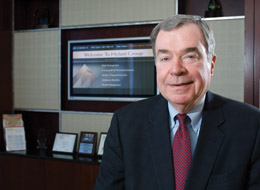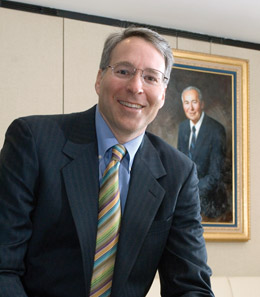From better to best: The power of benchmarking
Hylant Group teams up with Active Retention to boost service and performance
By Elisabeth Boone, CPCU
As a fourth-generation, family-owned insurance brokerage with revenue of more than $100 million, Hylant Group is clearly doing something right.
Founded in Toledo, Ohio, in 1935, Hylant is ranked as the 21st largest insurance agency in the United States and, according to the Hales Report, is the fifth largest privately held broker in the nation. Through its staff of some 650 professionals, Hylant offers complete risk management services, employee benefits, loss control, 401(k) and financial services, disease and lifestyle management, and insurance for businesses and individuals regionally, nationally, and around the world.
In addition to its corporate headquarters in Toledo, Hylant has offices in Cincinnati, Columbus, and Cleveland, Ohio; Ann Arbor, Grand Rapids, and Troy, Michigan; Indianapolis, Bloomington, and Fort Wayne, Indiana; and Nashville, Tennessee.
Active in the international insurance market, Hylant is a member of the Worldwide Broker Network and has brokerage relationships in more than 100 countries.
In 2006 Hylant decided it needed some data on how it stands in relation to its peers, as well as a formal process for ascertaining the level of client satisfaction with its products and services. It retained the services of Active Retention, a consultancy in Concord, Massachusetts, that specializes in retention, renewal, and cross-selling. Active Retention’s two hallmark products are the Client Service Review™ and the National Benchmarking Module™. Hylant Group conducted the client survey first and then began the benchmarking process.
Time for a change
Despite its size and impressive client roster, Hylant traditionally hadn’t been aggressive in seeking client feedback. “We spent a lot of time engaging our top clients,” says Richard Hylant, president of the Toledo office and regional vice president of the three Indiana locations. “When we were out with them, we’d ask, ‘How’s it going?’ Our approach was basically opportunistic, as opposed to inviting feedback in an organized fashion.”
Adds Bill Buckley, Hylant’s chief operating officer, “For our large accounts, we have a client coordinator who deals with higher-level executives like the chief financial officer or the chief purchasing officer, so this is another way of getting feedback. In our Cleveland office, the client coordinator developed an internal system to measure client satisfaction. Overall, though,” Buckley observes, “our client feedback was largely anecdotal, and it was more qualitative than quantitative.”
When and why did Hylant decide to seek a more structured, formal approach to obtaining feedback from clients?
“We were in the process of completing a series of sales training exercises with Randy Schwanz and The Wedge Group,” Buckley says. “In the course of that process, we realized it was appropriate for us to get much more quantitative feedback from our clients. At about that time, Alan Blume of Active Retention contacted us. Alan made several trips here to Toledo to present Active Retention’s services, and we were very impressed. We checked with a couple of Active Retention clients and got positive feedback from them, so we decided to move ahead.”
First, Active Retention worked with Hylant to implement its Web-based Client Service Review, which is designed to help agencies obtain actionable feedback about service-related issues and other concerns. The process also seeks to identify cross-selling and referral opportunities as well as potential retention challenges. (See “How Are We Doing?” in the August 2005 issue of Rough Notes.)
Getting started
Active Retention works with agencies of all sizes and has developed a series of basic to advanced technologies and applications that together make up a highly sophisticated set of tools. Although the Client Service Review is straightforward and logical, training is required to bring agency employees up to speed on implementing the process.
“Active Retention conducted a series of Webinars with our 11 office coordinators to discuss the basics of the Client Service Review and obtain their buy-in to the process,” Buckley says. “Something that was attractive to us is that we were able to have input into the design of the questionnaires. The basic template was very sophisticated, and we were able to modify it to make it more responsive to the needs of the Hylant Group.”
As a next step, “We developed a contact spreadsheet, and this is probably one of the more critical parts of the process,” Buckley comments. “We wanted to do a survey at each one of our offices, not just one or two, and we generated a list of 550 client contacts. Our largest offices are Toledo and Cleveland, so we had 100 contacts from each of those locations.”
With that task completed, Buckley says, “We were off and running. Active Retention visited each of our offices to conduct training, and we were comfortable with their approach. While the Client Service Review is a straightforward system, it’s fairly complex and has a lot of bells and whistles, and we wanted to make sure we understood the process.”
Equally important, Buckley notes, “We were confident that the Active Retention people shared our sensitivity to the importance of the information on the contact spreadsheet.”
Responses and results
In general, surveys don’t tend to draw high response rates. Many people don’t want to take the time to answer a long list of questions, especially if they can’t see how they’ll benefit from doing so.
In contrast, the Hylant Group’s Client Service Review drew an impressive 67% response—well above the 50% rate that Active Retention guarantees. One reason for this high level of participation is that clients are invited by personal letter to complete the survey rather than just having it thrust upon them. Second, the questionnaire can be completed either online or on paper in just 12 to 15 minutes.
Speedy turnaround and quick action put the survey results to work almost immediately: within 24 hours of survey completion, Active Retention delivers a report to the agency that presents results and suggests appropriate follow-up steps. Next, each survey respondent is asked to meet or speak by phone with his or her primary contact at the agency. This allows the contact person to address issues identified in the survey, such as retention-related concerns, cross-selling opportunities, and potential referrals.
“One of the key selling points of Active Retention was that they guaranteed a high response rate,” Buckley says. Adds John McDermott, vice president of sales, Toledo, “Of our total survey base, only 9% opted out of responding, and most of that was because we had invited a CEO and he deferred to the CFO, or some similar situation.”
Actual turndowns were rare, Richard Hylant says, and those responses were taken seriously. “If a client simply opted out, that sent a message that was just as important as a survey response. I followed up with those people myself.”
Although there were no real surprises in the Client Service Review process, the Hylant executives agree that it was a valuable exercise because it introduced a formal, ongoing process for inviting and acting on client feedback.
“If you survey 550 clients, you’re going to come across somebody who’s not happy about something,” Hylant observes. “We hope we do, because then we may have the chance to do what it takes to keep them. We came across a few situations like that, and I can’t say we were surprised, given the size of our organization and the diverse personalities of our employees and our clients. It did give us an opportunity to head a few off at the pass. In one case I talked to a client, and they decided to move, which I understood,” Hylant says. “But I think that after engaging them the way we did, the door is now open for them to return, whereas before I think it would have been slammed tight for years.”
On to benchmarking
Everyone in the insurance brokerage community is familiar with—and eagerly awaits—the annual Business Insurance survey of the top 100 brokers, as well as other prominent broker rankings like the Hales Report. Such surveys perform a benchmarking function in the sense that they show firms where they stand with respect to their peers on certain criteria, and top firms clearly benefit because their high rankings attract new business.
Active Retention takes the process one step further. Its National Benchmarking Module not only shows an agency how it’s performing with respect to its peers but also identifies ways in which the agency can improve its performance in such areas as sales, service, invoicing, training, responsiveness, and customer appreciation. An agency can compare its scores with the aggregated high, low, and average scores of more than 50 other agencies in Active Retention’s benchmark pool and use the information to identify its own strengths and weaknesses.
The data for the benchmarking module is drawn from the responses Active Retention’s agency clients receive to their Client Service Review. All responses remain confidential, and only data from agencies that specifically choose to participate are included in the benchmarking database. No one knows which agencies are in the database.
The database includes agencies of all sizes, ranging from firms of $5 million or less to large top 10 agencies. The database is customized for each agency, because not every agency uses the same questions in its Client Service Review survey. Active Retention usually develops between 20 and 25 key metrics per agency for its benchmarking process.
Agencies can compare their results with the national high/low/average in such areas as Sales Team Performance, Sales Executive Performance, Service Team Performance, Service Representative Performance, Renewals, Polices, Statements, Training, Risk Reviews, Continuity of Staff, and other categories. These benchmarks can be filtered dynamically by office, region, product line manager, and staff personnel.
The Hylant Group has the distinction of being the first agency to use the National Benchmarking Module. Using this product, “We were able to see exactly how we stacked up with other participants in the program,” McDermott says. “In some cases the results were surprising, and in other cases they weren’t. Overall, our loyalty factor was very strong, at 95%, and the majority of that was favorable or exceptional. That was very gratifying,” he says.
“Among the smaller number of responses where we had some issues, they weren’t necessarily surprising, but they did confirm some of our thoughts,” McDermott continues. “Overall, it was a very beneficial exercise in terms of getting positive feedback and also learning where we needed to focus our efforts.”
What’s new?
Active Retention is continually building out its portfolio of assessment tools for agencies and brokerages. Among its new offerings is a Client Testimonial Service to help agencies capitalize on their positive client relationships. Professional writers, editors, and graphic artists create compelling testimonials based on client interviews. The finished product can be used for collateral promotional campaigns and posting on the agency’s Web site.
Another new service is the Lost Client Review, which is designed to generate empirical information about why clients are moving to competitors. Specific issues are identified via Web-based surveys, in-person visits, and telephone interviews. *
For more information:
Active Retention, LLC
Phone: (508) 720-3457
Web site: www.activeretention.com |
|
Click on image for enlargement |
 |
| |
From left, John McDermott, Willam Buckley and Richard Hylant assess a portion of the Client Service Review, developed by Active Retention for the Hylant Group. The survey drew an impressive 67% response rate.
|
| |
 |
| |
“We were able to have input into the design of the questionnaires. The basic template was very sophisticated, and we were able to modify it to make it more responsive to the needs of the Hylant Group.”
—William Buckley |
|
| |
 |
| |
Richard Hylant, President of the Toledo office and Regional VP of the three Indiana locations, represents a fourth-generation in the family-owned insurance brokerage, now with revenues in excess of $100 million. |
|


